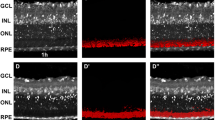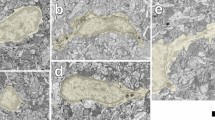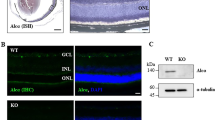Abstract
Neurofilaments (NFs) consist of three protein subunits with apparent molecular weights of 68,000 (68K), 145K and 200K, which are found closely associated in most but not all locations in the nervous system1–4. One of these exceptions is the inner retina of the mouse, where antibodies to 145K NFs label large ganglion cells throughout the extent of the cells, while antibodies to 200K NFs label only more distal portions of the optic axons but usually fail to label the ganglion cell somata and proximal axons5,6. Very rarely, however, and more often in old mice, anti-200K NF antibodies do label a ganglion cell completely5. To determine whether these rare, completely labelled cells reflect a pathological alteration, we cut the optic axons, and report here that after a few days some of the axotomized cells could be labelled completely, in a Golgi-like fashion, by anti-200K NF antibodies. These cells seem to represent the population that forms the projection to the bulk of the lateral geniculate nucleus, as suggested by their size, distribution and projection pattern. Hence, antibodies to the heavy NF subunit in combination with lesions may allow selective retrograde tracing of a subpopulation of ganglion cells, and such antibodies can be used to detect damage in NF-rich neurones at a very early stage, long before they eventually degenerate.
This is a preview of subscription content, access via your institution
Access options
Subscribe to this journal
Receive 51 print issues and online access
$199.00 per year
only $3.90 per issue
Buy this article
- Purchase on Springer Link
- Instant access to full article PDF
Prices may be subject to local taxes which are calculated during checkout
Similar content being viewed by others
References
Hoffman, P. & Lasek, R. J. J. Cell Biol. 66, 351–366 (1975).
Willard, M. & Simon, C. J. Cell Biol. 89, 198–205 (1981).
Sharp, G. A., Shaw, G. & Weber, K. Expl Cell Res. 137, 403–413 (1982).
Shaw, G. & Weber, K. Nature 298, 277–279 (1982).
Dräger, U. C., Edwards, D. L. & Barnstable, C. J. J. Neurosci. (in the press).
Dräger, U. C., Edwards, D. L. & Kleinschmidt, J. J. Proc. natn. Acad. Sci. U.S.A. 80, 6408–6412 (1983).
Lieberman, A. R. Int. Rev. Neurobiol. 14, 49–124 (1971).
Ramon y Cajal, S. Degeneration and Regeneration of the Nervous System (ed. May, R. M.) (Oxford University Press, 1928).
Stone, J. J. comp. Neurol. 126, 585–600 (1966).
Grafstein, B. & Ingoglia, N. A. Expl Neurol. 76, 318–330 (1982).
Moss, T. H. & Lewkowicz, S. J. J. neurol. Sci. 60, 267–280 (1983).
Dräger, U. C. & Olsen, J. F. J. comp. Neurol. 191, 383–412 (1980).
Goldberg, S. & Galin, M. A. Invest. Ophthal. vis. Sci. 12, 383–385 (1973).
Gambetti, P., Autilio-Gambetti, L. & Papasozomenos, S. C. Science 213, 1521–1522 (1981).
Dräger, U. C. & Hubel, D. H. J. Neurophysiol. 38, 690–713 (1975).
Dräger, U. C. & Hubel, D. H. J. Neurophysiol. 39, 91–101 (1976).
Dräger, U. C. J. comp. Neurol. 160, 269–290 (1975).
Lund, R. D., Lund, J. S. & Wise, R. P. J. comp. Neurol. 158, 383–404 (1974).
Bunt, S. M., Lund, R. D. & Land, P. W. Devl Brain Res. 6, 149–168 (1983).
Sternberger, L. A. & Sternberger, N. H. Proc. natn. Acad. Sci. U.S.A. 80, 6126–6130 (1983).
Anderton, B. H. et al. Nature 298, 84–86 (1982).
Sternberger, L. A., Harwell, L. W. & Sternberger, N. H. Proc. natn. Acad. Sci. U.S.A. 79, 1326–1330 (1982).
Lee, V., Wu, H. L. & Schlaepfer, W. W. Proc. natn. Acad. Sci. U.S.A. 79, 6089–6092 (1982).
Dräger, U. C. Nature 303, 169–172 (1983).
Ogden, T. E. Wenner-Gren int. Symp. Ser. 10, 89–111 (1966).
Hofbauer, A. & Dräger, U. C. Invest. Ophthal. vis. Sci. 20, (Suppl.) 175 (1981).
Author information
Authors and Affiliations
Rights and permissions
About this article
Cite this article
Dräger, U., Hofbauer, A. Antibodies to heavy neurofilament subunit detect a subpopulation of damaged ganglion cells in retina. Nature 309, 624–626 (1984). https://doi.org/10.1038/309624a0
Received:
Accepted:
Issue Date:
DOI: https://doi.org/10.1038/309624a0
This article is cited by
-
Monoclonal antibody Py recognizes neurofilament heavy chain and is a selective marker for large diameter neurons in the brain
Brain Structure and Function (2017)
-
IOP induces upregulation of GFAP and MHC-II and microglia reactivity in mice retina contralateral to experimental glaucoma
Journal of Neuroinflammation (2012)
-
Acetylcholinesterase inhibitor treatment delays recovery from axotomy in cultured dorsal root ganglion neurons
Journal of Neurocytology (1996)
-
The ganglion cell response to optic nerve injury in the cat: differential responses revealed by neurofibrillar staining
Journal of Neurocytology (1994)
-
Probing modifications of the neuronal cytoskeleton
Molecular Neurobiology (1993)
Comments
By submitting a comment you agree to abide by our Terms and Community Guidelines. If you find something abusive or that does not comply with our terms or guidelines please flag it as inappropriate.



